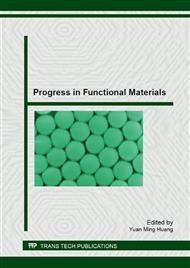[1]
M. Sagawa, S. Fujimura, N. Togawa, H. Yamamoto, Y. Matsuura, New material for permanent magnets on a base of Nd and Fe, J. Appl. Phys. 55 (1984) 2083-2087.
DOI: 10.1063/1.333572
Google Scholar
[2]
D. Brown, B.M. Ma, Z.M. Chen, Developments in the processing and properties of NdFeB-type permanent magnets, J. Magn. Magn. Mater. 248 (2002) 432-440.
DOI: 10.1016/s0304-8853(02)00334-7
Google Scholar
[3]
G.L. Yan, A.J. Williams, J.P.G. Farr, I.R. Harris, The effect of density on the corrosion of NdFeB magnets, J. Alloys. Compd. 292 (1999) 266-274.
DOI: 10.1016/s0925-8388(99)00443-0
Google Scholar
[4]
M.X. Guan, Application of hot isostatic presses in power metallurgy, Tianjin Metall. 104 (2001) 41-44.
Google Scholar
[5]
S.J. Mash, Hot isostatic pressing: more than a niche technology, Int. J. Powder Metall. 44 (2008) 27-30.
Google Scholar
[6]
N. Rodríguez, J.M. Sánchez, M. Aristizabal, Consolidation of (Ti-Mo)(C,N)-Ni cermets by glass encapsulated hot isostatic pressing, Mater. Sci. Eng., 528 (2011) 4453-4461.
DOI: 10.1016/j.msea.2011.02.008
Google Scholar
[7]
G.C. Liu, Y.S. Shi, Q.S. Wei, J.W. Wang, Finite element analysis of pressure influence on densification of titanium alloy powder under hot isostatic pressing, in: D.Z. Su, Q.B. Zhang, S.F. Zhu (Eds.), Proceeding of 3rd International Conference on Advanced Design and Manufacture, Trans Tech Publications Ltd., Nottingham, UK, 2010, pp.206-209.
DOI: 10.4028/www.scientific.net/kem.450.206
Google Scholar
[8]
J. Mouzon, A. Maitre, L. Frisk, N. Lehto, M. Odén, Fabrication of transparent yttria by HIP and the glass-encapsulation method, J. Eur. Ceram. Soc. 29 (2009) 311-316.
DOI: 10.1016/j.jeurceramsoc.2008.03.022
Google Scholar
[9]
D. Das, K. Kumar, Hot isostatically pressed SmCo5 magnets, IEEE Trans. Magn. 16 (1980) 1000-1002.
DOI: 10.1109/tmag.1980.1060795
Google Scholar
[10]
M. Endoh, M. Tokunaga, H. Harada, Magnetic properties and thermal stabilities of Ga substituted Nd-Fe-Co-B magnets, IEEE Trans. Magn. 23 (1987) 2290-2292.
DOI: 10.1109/tmag.1987.1065291
Google Scholar
[11]
X.G. Cui, M. Yan, T.Y. Ma, L.Q. Yu, Effects of Cu nanopowders addition on magnetic properties and corrosion resistance of sintered Nd-Fe-B magnets, Physica B 403 (2008) 4182-4185.
DOI: 10.1016/j.physb.2008.09.002
Google Scholar
[12]
K. Tokuhara, S. Hirosawa, Corrosion resistance of NdFeB sintered magnets, J. Appl. Phys. 69 (1991) 5521-5226.
Google Scholar
[13]
M. Shimotomai, Y. Fukufa, A. Fujita, Y. Ozaki, Corrosion resistant Nd-TM-B magnet, IEEE. Trans. Magn. 26 (1990) 1939-1941.
DOI: 10.1109/20.104577
Google Scholar
[14]
H. Bala, S. Szymura, Corrosion characteristics of Co5Sm permanent magnets, Appl. Surf. Sci., 32 (1988) 233-238.
DOI: 10.1016/0169-4332(88)90083-9
Google Scholar


